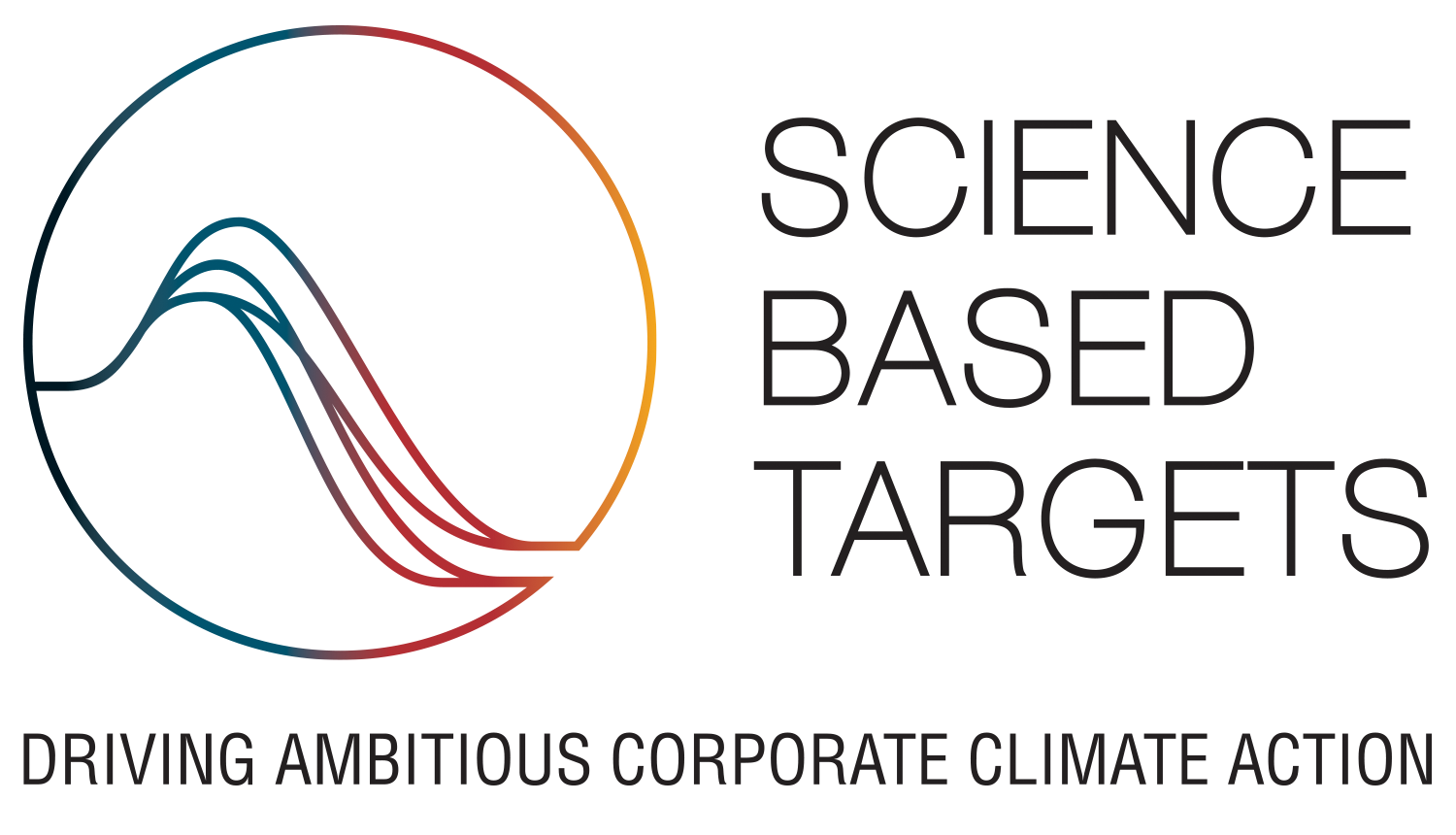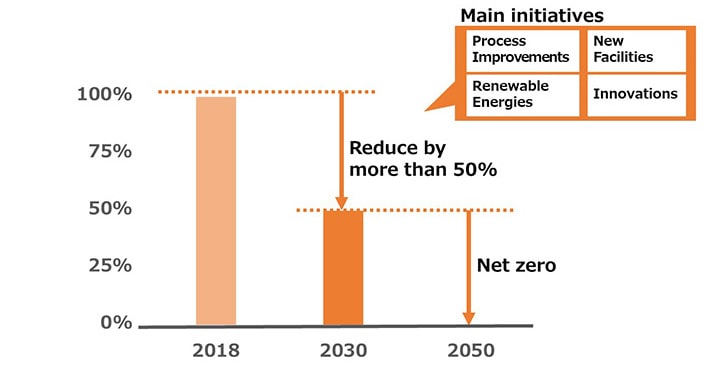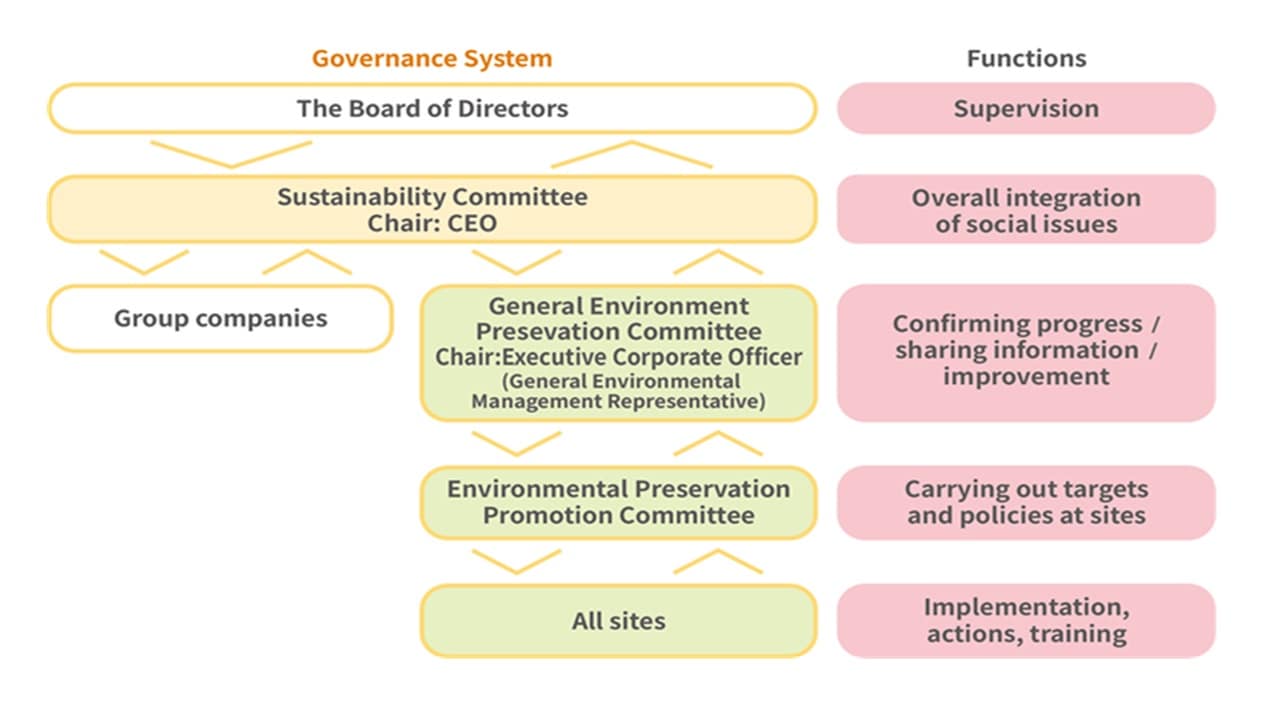Climate Change
“Global Vision 2030” expresses our vision of the future for the Kikkoman Group. It states our “goals” and strategies to achieve these by the year 2030, including our goal to “become a company whose presence in global society is ever more meaningful, through activities unique to Kikkoman.” We want to contribute to solving global issues, so that the company will be valued by people around the world.
In recent years, many places around the world have faced social issues such as health problems, water shortages, and flooding due to high temperatures and heatwaves. The damage from these issues has continued to grow. These types of abnormal weather are strongly related to climate change, and are social issues that threaten life, finance, and economic activity on a global scale. In light of this, climate change has been incorporated as one of the Sustainable Development Goals, and long-term goals have also been defined within the Paris Agreement.
Based on the long-term goals in the Paris Agreement, the Kikkoman Group is working to reduce CO2 emissions and seeking to realize net-zero CO2 by 2050. In order to contribute to the achievement of the long-term goal of pursuing efforts to limit the temperature increase from pre-industrial times to "1.5℃", we are promoting initiatives to cut at least 50% of CO2 emissions by 2030 compared with 2018 based on our Long-Term Environmental Vision.
Medium- and long-term reduction targets for CO2 emissions
Our targets have been approved by the Science Based Targets initiative (SBTi), and the targets are shown below.
To reduce absolute scope 1 and 2 GHG emissions 50.4% by FY2031 form a FY2019 base year.
To reduce absolute scope 3 GHG emissions 30% within the same timeframe.
Scope1・・・Direct emissions of greenhouse gases by an organization (fuel combustion, industrial processes)
Scope2・・・Indirect emissions associated with the use of electricity, heat and steam supplied by other entities
Scope3・・・Indirect emissions other than Scope1 and Scope2 (emissions by other entities related to a organization’s activities)
CO2 emission reduction target(Scope1+ Scope2)

- *Net zero CO2 emissions means to achieve an overall balance between CO2 emissions produced and CO2 emissions removed
- *In June 2023, we renewed our target for 2030 from 30% or more to 50% or more.
The amount of CO2 emissions
Total CO₂ emissions(Scope1) (thousand t-CO₂e)
| FY2019 | FY2021 | FY2022 | FY2023 | FY2024 | FY2025 | ||
| Japan | 73.1 | 72.5 | 69.9 | 66.2 | 58.9 | 60.0 | |
| Overseas Manufacturing & Sales | 24.9 | 24.4 | 26.9 | 26.4 | 26.1 | 27.3 | |
| Overseas Wholesale | 14.8 | 14.0 | 15.4 | 15.1 | 14.9 | 15.1 | |
| Total | 112.8 | 110.9 | 112.3 | 107.7 | 99.9 | 102.4 |
Total CO₂ emissions(Scope2) (thousand t-CO₂e)
| FY2019 | FY2021 | FY2022 | FY2023 | FY2024 | FY2025 | ||
| Japan | 56.8 | 52.3 | 40.5 | 16.3 | 12.8 | 11.5 | |
| Overseas Manufacturing & Sales | 47.1 | 42.4 | 36.8 | 31.1 | 29.5 | 26.3 | |
| Overseas Wholesale | 12.9 | 14.5 | 16.6 | 10.5 | 7.4 | 4.4 | |
| Total | 116.9 | 109.2 | 93.8 | 57.9 | 49.7 | 42.1 |
Total CO₂ emmisions(Scope3) (thousand t-CO₂e)
| FY2019 | FY2021 | FY2022 | FY2023 | FY2024 | FY2025 | ||
| Japan | 760.9 | 722.7 | 734.7 | 794.0 | 706.6 | 751.0 | |
| Overseas Manufacturing & Sales | 374.9 | 377.1 | 414.1 | 415.4 | 405.3 | 451.2 | |
| Overseas Wholesale | 1,007.0 | 1,040.1 | 1,178.7 | 1,322.6 | 1,211.5 | 1,250.4 | |
| Total | 2,142.8 | 2,139.8 | 2,327.4 | 2,532.0 | 2,323.4 | 2,452.7 |
| Scope3 By Category | FY2019 | FY2021 | FY2022 | FY2023 | FY2024 | FY2025 | |
| Total | 2,142.8 | 2,139.8 | 2,327.4 | 2,532.0 | 2,323.4 | 2,452.7 | |
| Category 1 Purchased goods and services | 1,569.0 | 1,587.5 | 1,723.3 | 1,868.4 | 1,676.7 | 1,752.9 | |
| Category 2 Capital goods | 90.2 | 66.6 | 78.4 | 122.2 | 136.5 | 147.0 | |
| Category 3 Fuel - and energy-related activities | 49.3 | 50.3 | 51.8 | 49.3 | 43.3 | 44.8 | |
| Category 4 Upstream transportation and distribution | 322.4 | 325.0 | 353.1 | 371.5 | 345.5 | 360.7 | |
| Category 5 Waste generated in operations | 5.7 | 5.3 | 5.6 | 7.8 | 7.4 | 8.3 | |
| Category 6 Business travel | 0.9 | 1.0 | 1.0 | 1.0 | 1.0 | 1.0 | |
| Category 7 Employee commuting | 2.6 | 2.8 | 2.8 | 2.9 | 2.8 | 2.9 | |
| Category 8 Upstream leased assets | 0.4 | 0.4 | 0.4 | 0.3 | 0.4 | 0.3 | |
| Category 9 Downstream transportation and distribution | 20.9 | 21.1 | 23.1 | 22.5 | 25.9 | 27.5 | |
| Category 10 Processing of sold products | 46.5 | 43.4 | 47.1 | 46.4 | 44.7 | 50.7 | |
| Category 11 Use of sold products | 0.0 | 0.0 | 0.0 | 0.0 | 0.0 | 0.0 | |
| Category 12 End-of-life treatment of sold products | 34.8 | 36.5 | 40.7 | 39.7 | 39.2 | 56.6 | |
| Category 13 Downstream leased assets | 0.0 | 0.0 | 0.0 | 0.0 | 0.0 | 0.0 | |
| Category 14 Franchises | 0.0 | 0.0 | 0.0 | 0.0 | 0.0 | 0.0 | |
| Category 15 Investments | 0.0 | 0.0 | 0.0 | 0.0 | 0.0 | 0.0 |
- *For information on each Scope3 category, please refer to the following website.
- https://ghgprotocol.org/scope-3-calculation-guidance-2
- Notes:
・CO2e stands for CO2 equivalent and shows the value of greenhouse gases converted to carbon dioxide.
Verification
For the FY2024 greenhouse gas (GHG) emissions and environmental information (water usage), we have obtained a third-party verification statement from Japan Management Association Sustainability Center to enhance reliability.
Greenhouse gas emissions / Environmental Information Verification Statement [PDF:3.8MB]
Disclosures based on TCFD recommendations
The Kikkoman Group recognizes that climate change is one of the most serious issues facing international society. Our Group believes that addressing climate change equates to putting into practice our Management Principles aimed at becoming a company whose existence is meaningful to global society, and also has financial implications directly connected to the resilience of our strategies for sustainable growth.
Our Group has declared its support for the Task Force on Climate-related Financial Disclosures (TCFD) of the Financial Stability Board (FSB). Based on TCFD recommendations, we evaluate risks and opportunities concerning our operations stemming from climate change, and disclose information on our governance, strategy, risk management, indicators, and targets.
Governance
The CEO serves as the chief executive officer for the Group overall, while the Group Management Committee serves as a deliberative body for decision-making. At meetings of the Group Management Committee, discussions are held concerning policy formulation and initiative reinforcement and risks and opportunities are constantly monitored, with social and environmental issues regarded as key management topics. With regard to addressing climate change, the Company also formulates long-term business plans with the Kikkoman Group Long-Term Environmental Vision as a key pillar. To align issues identified in this vision with the Group’s strategies, the CEO reports on to the Board of Directors on progress toward climate-related targets. Based on these reports, the Board of Directors determines and supervises the Group’s major policies, including those related to climate change, and incorporates these in the Group’s business strategy.
The Group has also established a Sustainability Committee in which the CEO participates. This committee is tasked with leading Group-wide initiatives to tackle climate change and other societal issues based on the Group’s business strategy. The Sustainability Committee secretariat examines societal issues, including climate change, and engages in reporting and discussions in the Group Management Committee and other committees.
The General Environment Preservation Committee, headed by the Kikkoman Corp. General Manager, disseminates details about targets and policies related to climate change and other environmental protection activities to Group companies and business site organizations. It also promotes the accumulation of expertise and technologies related to the environment and improves the Group’s responsiveness to change. The Environmental Preservation Promotion Committee, placed under the General Environment Preservation Committee and composed mainly of sites’ environmental management officers, facilitates the sharing of detailed data and case studies.

Strategy
In 2018, the Group formulated Global Vision 2030 (GV2030) as its long-term vision for defining basic strategies and goals based on its Management Principles. In formulating GV2030, management analyzed material issues from societal perspectives and the Group’s perspectives, and identified three core material issues: “the global environment,” “food and health,” and “people and society.” The Kikkoman Group Long-Term Environmental Vision, our environmental vision aimed at 2030, was established in 2020 to guide specific measures. While advancing activities under this vision and others, the Group has long understood that flooding risks associated with earthquakes and climate change could result in business disruptions and weaker earnings. Accordingly, the Group has advanced measures including business continuity planning (BCP) and natural disaster simulation. Across the Group, we carefully watch the potential for major impacts on operations due to climate change, such as changes that climate change could cause to the use of natural materials in core products. Amid growing concerns in society over the risks of climate change, the Group follows the TCFD recommendation to analyze risks in multiple scenarios that could affect our business domains, to quantifiably measure risks and medium- to long-term impacts on the Group stemming from climate change.
Scenario Analysis
The Group’s scenario analysis is based on Representative Concentration Pathways (RCP) scenarios, with reference to reports by the Intergovernmental Panel on Climate Change (IPCC) and net-zero scenarios (NZE) from the International Energy Agency (IEA). Analytical results and estimated impacts on Group operations for each scenario are outlined below.
| Climate change scenarios and models | Content |
|---|---|
| RCP 2.6 RCP 8.5 |
Summary of scenario analysis: Results of scenario analysis: Impacts of scenario analysis results on business strategy: |
| RCP 2.6 RCP 8.5 |
Summary of scenario analysis: Results of scenario analysis: Impacts of scenario analysis results on business strategy: |
|
IEA NZE Scenario |
Summary of scenario analysis: Results of scenario analysis: Impacts of scenario analysis results on business strategy: |
Processes for identifying, assessing, and addressing climate-related risks and opportunities
The Kikkoman Corp. Corporate Planning Department takes the lead in comprehensively evaluating risks related to the Kikkoman Group’s business every year. Climate change-related issues are included among the risks integrated into a multi-specialty Company-wide risk management process. For risk cases that affect our business, we evaluate cases involving direct operations as well as upstream and downstream areas of the value chain. Based on this, several times a year we perform analysis and evaluation of degrees of impact under multiple time frames, and issue reports and proposals to top management, including the CEO.
As a method of identifying and classifying climate-related water risks such as heavy rains and droughts, we make use of in-house knowledge along with evaluation tools including the Water Risk Filter from the World Wide Fund for Nature (WWF) and Aqueduct from WRI. When evaluation tool findings yield relevant indicators that exceed normal levels, we recognize water risk to be high and supplement our in-house knowledge with the information. These evaluation tools allow us to reference objective indicators for a wide range of water risks, including regulatory risks, reputational risks, and other difficult-to-quantify risks.
We define the potential financial impacts of climate change risks and opportunities, along with impacts on our stock market capitalization, as significant impacts. When risks of manufacturing site stoppages in major businesses present strategic impacts, we deem those to be risks with significant impact.
In the identification and evaluation of climate-related risks, every quarter the Group Management Committee conducts evaluations of risks involving the Group as a whole. Based on these evaluations, risks with the potential to affect the Group’s performance and financial position are noted as “risks to business, etc.” in our securities reports. Applicable risks are described under items such as natural disasters and changes in market conditions for materials, as “social and economic environment”-related risks. Business risks and opportunities stemming from climate change based on TCFD recommendations are noted as “business environment”-related risks.
Key climate-related risks
The core business of the Kikkoman Group is the manufacture and sale of soy sauce, soy milk, ketchup, and tomato juice. Sales of the domestic and international food manufacturing and sales segments, including our core business, in the fiscal year ended March 2024 were 302,228 million yen, accounting for about 46% of overall Group sales. The key materials used in our food manufacturing businesses are agricultural products including soybeans, wheat, and tomatoes, the cultivation of which is greatly affected by climate change. Soy sauce business and soy milk business sales of 214,549 million yen account for a major portion of total Group sales (about 32%). The soybeans and wheat used in soy sauce and the soybeans used in soy milk are affected by market conditions for these agricultural products. The materials used by our Group must pass our strict quality and food safety standards, and are procured from limited sources. For this reason, changes in the amount of rainfall and effects of drought and heavy rains in cultivation areas due to climate change present risks.
Over 90% of the soybeans used in the soy sauce we produce comes from North America. Frequent natural disasters and extreme droughts in the North American region caused by climate change can change supply and demand relationships, resulting in procurement difficulties and soaring prices.
Key climate-related opportunities
The Kikkoman Group holds advantages in product development technologies centered on fermentation and brewing. We are able to leverage these strengths to process varied materials, including alternative materials that address material procurement challenges under climate change, to develop products that take advantage of natural umami. In this way, we are able to deploy competitive product groups made with alternative materials and create opportunities for pioneering new markets.
The Kikkoman Group manufactures soy sauce and other food products not only in Japan but also overseas. Through this, we have accumulated food manufacturing know-how and technologies. In soy sauce brewing and fermentation processes, temperature control is important. At our Walworth Plant in the U.S., the average temperature in winter falls below freezing, so we adopted equipment capable of bringing in more cold outside air for use in temperature control, which reduces CO2 emissions from the operation of refrigeration equipment.
Through innovation in manufacturing processes and equipment, the Kikkoman Group carries out manufacturing more efficiently, enhancing our productivity and allowing us to manufacture products in a manner suited to a low-carbon society. Such measures incorporate innovations in manufacturing processes and equipment, leading to more efficient manufacturing, enhanced productivity, and opportunities for reducing costs.
Risk Management
At the Group, to fulfill its responsibilities to stakeholders and realize stable business development, the Group advances initiatives to prepare for risks that may affect the activities of the Group. Given the global reach of the Group’s many businesses, there are a variety of different risks and opportunities that must be understood and managed. Executive officers at subsidiaries and business divisions are put in charge of preventing the materialization of risks.
In October 2010, with the objective of accurately managing the various risks faced by the Group, the Group formulated the Kikkoman Group Risk Management Guideline (Risk Management Guideline), which lays out the basic elements of risk management. In the Risk Management Guideline, risk is defined as all uncertainties in management and includes the following. Its definition of risk goes beyond natural disasters and accidents to include environmental problems, such as climate change.
- 1Possibilities to cause direct or indirect economic loss to the Kikkoman Group
- 2Possibilities to interrupt or stop business continuity of the Kikkoman Group
- 3Possibilities to cause damage to the credibility of the Kikkoman Group and undermine brand images
The Group analyzes scenarios to assist with the evaluation, management and appropriate response to climate-related risks over the medium to long term, while identifying and addressing physical risks and transition risks. Through partnerships with external organizations (Japan Climate Initiative,Japan Climate Leaders’ Partnership and The Consumer Goods Forum), the Group ascertains the attitudes and regulations of countries regarding climate change, and reflects this information in its initiatives as necessary. Every year, the Group comprehensively assesses the business-related risks of the Group, and the issue of climate change is one such risk. The Group identifies risks that affect operations and analyzes the degree of impact of each risk, and submits risk reports to the Board of Directors.

Metrics and Targets
The United Nations Framework Convention on Climate Change (COP21) adopted the Paris Agreement in 2015 to keep the average increase in global temperatures to well below 2°C compared with before the industrial revolution, and try to keep the average temperature rise below 1.5°C.
In light of the long-term targets of the Paris Agreement, the Group aims to have net zero CO2 emissions by 2050, and set in motion initiatives to cut CO2 emissions. Based on its long-term environmental vision, the Group is working to reduce its CO2 emissions by 50% or more by 2030, compared with the fiscal 2019 level. The Group will periodically update its medium- to long-term plans for cutting CO2 emissions to align with technological innovations in the future.
Last updated: October, 2025
▶Some Cases of Environmental Preservation Activities Global Warming Prevention
